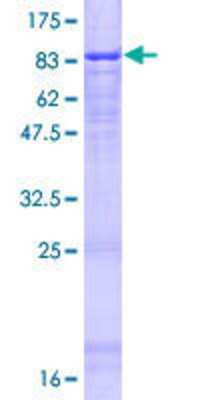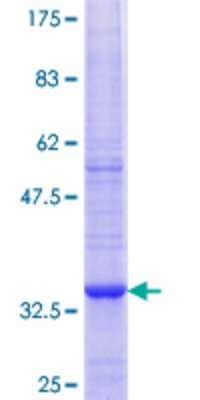ATG16L1 Products
Macroautophagy is the major inducible pathway for the general turnover of cytoplasmic constituents in eukaryotic cells, it is also responsible for the degradation of active cytoplasmic enzymes and organelles during nutrient starvation. Macroautophagy involves the formation of double-membrane bound autophagosomes which enclose the cytoplasmic constituent targeted for degradation in a membrane bound structure, which then fuse with the lysosome (or vacuole) releasing a single-membrane bound autophagic bodies which are then degraded within the lysosome (or vacuole). The APG12-APG5-APG16L complex is essential for the elongation of autophagic isolation membranes. This complex initially associates in uniform distribution with small vesicle membranes. During membrane elongation, the complex partitions, with a great concentration building on the outer side of the isolation membrane. Upon completion of the formation of the autophagosome, the APG12-APG5-APG16L dissociates from the membrane. There are 5 isoforms of this protein (in human), with theoretical molecular weights ranging from ~19-68 kDa.
Mutations in the ATG16L1 proitein have been associated with Crohn's disease.
Show More
Mutations in the ATG16L1 proitein have been associated with Crohn's disease.
61 results for "ATG16L1" in Products
61 results for "ATG16L1" in Products
ATG16L1 Products
Macroautophagy is the major inducible pathway for the general turnover of cytoplasmic constituents in eukaryotic cells, it is also responsible for the degradation of active cytoplasmic enzymes and organelles during nutrient starvation. Macroautophagy involves the formation of double-membrane bound autophagosomes which enclose the cytoplasmic constituent targeted for degradation in a membrane bound structure, which then fuse with the lysosome (or vacuole) releasing a single-membrane bound autophagic bodies which are then degraded within the lysosome (or vacuole). The APG12-APG5-APG16L complex is essential for the elongation of autophagic isolation membranes. This complex initially associates in uniform distribution with small vesicle membranes. During membrane elongation, the complex partitions, with a great concentration building on the outer side of the isolation membrane. Upon completion of the formation of the autophagosome, the APG12-APG5-APG16L dissociates from the membrane. There are 5 isoforms of this protein (in human), with theoretical molecular weights ranging from ~19-68 kDa.
Mutations in the ATG16L1 proitein have been associated with Crohn's disease.
Show More
Mutations in the ATG16L1 proitein have been associated with Crohn's disease.
Applications: IHC, WB, MS
Reactivity:
Human,
Mouse,
Rat,
Canine,
Bovine, +2 More
| Reactivity: | Human, Mouse, Rat, Canine, Bovine, +2 More |
| Details: | Rabbit IgG Polyclonal |
| Applications: | IHC, WB, MS |
Applications: WB, IP
Reactivity:
Human,
Mouse,
Rat
| Reactivity: | Human, Mouse, Rat |
| Details: | Rabbit IgG Polyclonal |
| Applications: | WB, IP |
Applications: IHC, WB, ICC/IF
Reactivity:
Human
| Reactivity: | Human |
| Details: | Rabbit IgG Polyclonal |
| Applications: | IHC, WB, ICC/IF |
| Applications: | AC |
| Applications: | AC |
Applications: IHC, Simple Western
Reactivity:
Human
| Reactivity: | Human |
| Details: | Rabbit Polyclonal |
| Applications: | IHC, Simple Western |
Applications: IHC, Simple Western
Reactivity:
Human
| Reactivity: | Human |
| Details: | Rabbit Polyclonal |
| Applications: | IHC, Simple Western |
Recombinant Monoclonal Antibody
| Reactivity: | Human, Mouse |
| Details: | Rabbit IgG Monoclonal Clone #5N2N9 |
| Applications: | WB |
| Reactivity: | Human |
| Details: | Rabbit IgG Polyclonal |
| Applications: | IHC |
| Applications: | WB, ELISA, MA, AP |
| Applications: | ELISA |
| Applications: | WB, ELISA, MA, AP |
| Applications: | AC |
| Reactivity: | Human |
| Details: | Rabbit IgG Polyclonal |
| Applications: | WB, IP |
| Applications: | WB |
Applications: WB, IP
Reactivity:
Human,
Mouse
| Reactivity: | Human, Mouse |
| Details: | Rabbit IgG Polyclonal |
| Applications: | WB, IP |
| Reactivity: | Human |
| Details: | Rabbit IgG Polyclonal |
| Applications: | IP |
| Applications: | ELISA |
Applications: IHC, WB, MS
Reactivity:
Human,
Mouse,
Rat,
Canine,
Bovine, +2 More
| Reactivity: | Human, Mouse, Rat, Canine, Bovine, +2 More |
| Details: | Rabbit IgG Polyclonal |
| Applications: | IHC, WB, MS |
Applications: IHC, WB, MS
Reactivity:
Human,
Mouse,
Rat,
Canine,
Bovine, +2 More
| Reactivity: | Human, Mouse, Rat, Canine, Bovine, +2 More |
| Details: | Rabbit IgG Polyclonal |
| Applications: | IHC, WB, MS |
Applications: WB, IP
Reactivity:
Human,
Mouse
| Reactivity: | Human, Mouse |
| Details: | Rabbit IgG Polyclonal |
| Applications: | WB, IP |
Applications: WB, IP
Reactivity:
Human,
Mouse
| Reactivity: | Human, Mouse |
| Details: | Rabbit IgG Polyclonal |
| Applications: | WB, IP |
| Reactivity: | Human, Mouse |
| Details: | Rabbit IgG Polyclonal |
| Applications: | WB, IP |
Applications: IHC, WB, MS
Reactivity:
Human,
Mouse,
Rat,
Canine,
Bovine, +2 More
| Reactivity: | Human, Mouse, Rat, Canine, Bovine, +2 More |
| Details: | Rabbit IgG Polyclonal |
| Applications: | IHC, WB, MS |
Applications: WB, IP
Reactivity:
Human,
Mouse
| Reactivity: | Human, Mouse |
| Details: | Rabbit IgG Polyclonal |
| Applications: | WB, IP |

![Western Blot: ATG16L1 AntibodyBSA Free [NB110-60928] Western Blot: ATG16L1 AntibodyBSA Free [NB110-60928]](https://resources.bio-techne.com/images/products/ATG16L1-Antibody-Western-Blot-NB110-60928-img0004.jpg)
![Western Blot: ATG16L1 AntibodyBSA Free [NB110-82384] Western Blot: ATG16L1 AntibodyBSA Free [NB110-82384]](https://resources.bio-techne.com/images/products/ATG16L1-Antibody-Western-Blot-NB110-82384-img0004.jpg)
![Western Blot: ATG16L1 Antibody [NBP2-15504] Western Blot: ATG16L1 Antibody [NBP2-15504]](https://resources.bio-techne.com/images/products/ATG16L1-Antibody-Western-Blot-NBP2-15504-img0001.jpg)
![Immunohistochemistry-Paraffin: ATG16L1 Antibody [NBP3-14544] Immunohistochemistry-Paraffin: ATG16L1 Antibody [NBP3-14544]](https://resources.bio-techne.com/images/products/ATG16L1)
![Western Blot: ATG16L1 Antibody (5N2N9) [NBP3-16236] Western Blot: ATG16L1 Antibody (5N2N9) [NBP3-16236]](https://resources.bio-techne.com/images/products/ATG16L1-Antibody-5N2N9-Western-Blot-NBP3-16236-img0001.jpg)
![Immunohistochemistry-Paraffin: ATG16L1 Antibody [NBP2-49408] Immunohistochemistry-Paraffin: ATG16L1 Antibody [NBP2-49408]](https://resources.bio-techne.com/images/products/ATG16L1-Antibody-Immunohistochemistry-Paraffin-NBP2-49408-img0003.jpg)

![ELISA: Human ATG16L1 - Ready-To-Use ELISA Kit (Colorimetric) [NBP3-31133] - Human ATG16L1 - Ready-To-Use ELISA Kit (Colorimetric)](https://resources.bio-techne.com/images/products/nbp3-31133_human-atg16l1-ready-to-use-elisa-kit-colorimetric-206202415314851.png)

![Immunoprecipitation:[NBP3-29201]- ATG16L1 Antibody](https://resources.bio-techne.com/images/products/nbp3-29201_rabbit-atg16l1-pab-23120251252830.jpg)
![Western Blot: ATG16L1 Overexpression Lysate [NBP2-06180] Western Blot: ATG16L1 Overexpression Lysate [NBP2-06180]](https://resources.bio-techne.com/images/products/ATG16L1-Overexpression-Lysate-Adult-Normal-Western-Blot-NBP2-06180-img0001.jpg)

![Immunoprecipitation:ATG16L1 AntibodyNBP3-29182] - ATG16L1 Antibody](https://resources.bio-techne.com/images/products/nbp3-29182_rabbit-atg16l1-pab-301220241652444.jpg)
![ELISA: Human ATG16L1 ELISA Kit (Colorimetric) [NBP3-27241] -](https://resources.bio-techne.com/images/products/nbp3-27241_human-atg16l1-elisa-kit-colorimetric-114202410253640.png)